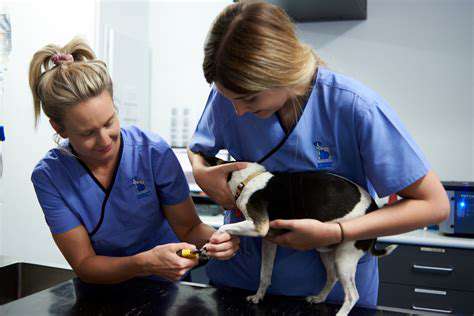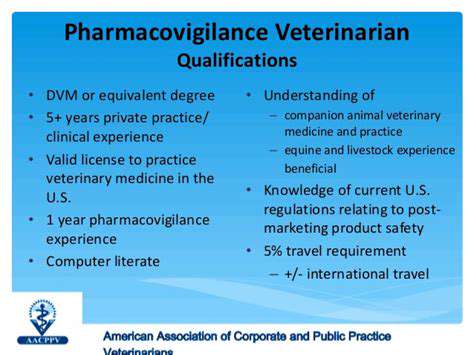Choosing the Right Vet: Essential Questions to Ask Before You Decide
Senior pets present different challenges - a 12-year-old Labrador might need biannual blood panels to monitor kidney function, while a geriatric cat benefits from thyroid checks and joint supplements. Look for clinics with: dedicated senior wellness programs, in-house diagnostic equipment for immediate testing, and staff trained in palliative care techniques.
Considering Your Pet's Lifestyle and Activity Level
Active sporting dogs like Border Collies participating in agility competitions require vets versed in sports medicine who can address: ligament injuries, heat stress management, and performance nutrition. Some progressive clinics now offer canine physical therapy and acupuncture for athletic pets.
For outdoor cats, prioritize clinics that emphasize: comprehensive parasite prevention programs (including tick-borne disease testing), wound care expertise, and toxic plant identification resources. Ask if they provide emergency services for after-hours wildlife encounters or toxin exposures.
Assessing Your Pet's Existing Health Conditions
Pets with chronic conditions demand specialized ongoing care. A diabetic cat needs a vet comfortable with: glucose curve interpretations, insulin adjustment protocols, and diabetic remission strategies. Look for clinics offering continuous glucose monitoring or telemedicine options for routine follow-ups.
For pets with allergies, seek practices providing: intradermal testing, custom immunotherapy preparation, and nutritional consultation for elimination diets. Advanced clinics may have veterinary dermatologists on staff or offer laser therapy for allergic dermatitis.
Determining Your Budget and Insurance Coverage
Financial planning for pet care requires understanding both routine and unexpected costs. Create a comparative analysis of: wellness plan options (often saving 20-30% on preventive care), emergency fund recommendations (typically $2,000-$5,000), and insurance reimbursement processes. Many practices now offer third-party financing options like CareCredit for unexpected expenses.
When evaluating costs, consider value-added services like: extended office hours that may prevent ER visits, online portals for prescription refills, and multi-pet discounts that can significantly reduce annual expenses.

Evaluating the Veterinarian's Communication Style and Approach
Understanding the Importance of Clear Communication
Exceptional veterinary communication bridges the knowledge gap between medical professionals and concerned pet owners. The best practitioners employ layered explanations: starting with simple analogies, then gradually introducing medical terminology as comprehension grows. Look for vets who proactively provide written summaries of diagnoses and treatment plans.
Red flags include: rushed explanations, dismissive attitudes toward questions, or overuse of technical jargon without clarification. Ideal clinics often supplement conversations with visual aids like anatomical models or digital displays showing test results.
Assessing the Veterinarian's Explanatory Skills
Top-tier veterinary educators break down complex concepts using relatable comparisons. For example, explaining kidney function through a water filtration system analogy helps owners understand renal disease management. Observe whether the vet tailors explanations to your educational background and emotional state.
Advanced clinics may provide: interactive body system apps for home education, procedure demonstration videos, or even virtual reality simulations showing surgical processes to enhance owner understanding.
Evaluating the Veterinarian's Empathetic Approach
True empathy manifests in both verbal and non-verbal communication. Exceptional veterinarians: kneel to pet level during exams, use calming pheromone diffusers in exam rooms, and allow happy visits where pets receive treats without procedures. Notice if staff members mirror this compassionate approach throughout the clinic.
For end-of-life care, the most compassionate practices offer: private grieving rooms, paw print memorials, and bereavement support resources. Some even partner with pet loss counselors for ongoing support.
Analyzing the Veterinarian's Active Listening Skills
Skilled listeners employ reflective techniques like: paraphrasing owner concerns, asking clarifying questions, and summarizing key points. The best consultations follow an 80/20 rule - the vet listens 80% of the time while guiding the conversation 20%.
Progressive clinics train staff in motivational interviewing techniques to better understand owner limitations and collaboratively develop achievable care plans. Look for vets who document your specific concerns in the medical record for future reference.
Considering the Veterinarian's Use of Visual Aids and Resources
Modern practices utilize increasingly sophisticated educational tools: digital body condition scoring apps, interactive weight management trackers, and 3D-printed models of specific conditions. Ask if the clinic provides customized home care videos demonstrating techniques like pill administration or wound care.
Some forward-thinking clinics offer: augmented reality apps showing medication mechanisms, online portals with condition-specific resources, or even virtual ask the vet sessions for quick questions between visits.
Observing the Veterinarian's Overall Professionalism and Demeanor
Professionalism extends beyond medical competence to encompass: punctuality (with transparent communication about delays), transparent pricing policies, and respectful team dynamics. Notice if the vet maintains composure during stressful situations while still showing appropriate emotional engagement.
The most reputable clinics demonstrate professionalism through: clean, odor-free facilities; well-organized medical records; and consistent follow-up protocols. Many now implement satisfaction surveys to continuously improve client experiences.
Understanding the Veterinarian's Experience and Credentials

Understanding Veterinary Examinations
Comprehensive veterinary assessments begin with detailed history-taking. Exceptional practitioners explore: environmental changes, subtle behavior shifts, and generational health patterns when available. Many clinics now use digital history forms that flag potential concerns before the exam begins.
Physical exam innovations include: digital otoscopes with image capture for ear issues, orthopedic gait analysis systems, and thermal imaging for pain detection. The most thorough vets document findings using standardized scoring systems for objective monitoring.
Diagnostic Tools and Techniques
Advanced diagnostic capabilities differentiate average clinics from exceptional ones. Look for practices offering: in-house PCR testing for rapid infectious disease results, digital radiography with specialist telemedicine consultations, and ultrasound with Doppler capabilities. Some specialty hospitals now provide CT or MRI imaging for complex neurological cases.
Cutting-edge laboratories utilize: automated CBC analyzers with advanced cell morphology, quantitative fecal PCR panels, and allergen-specific IgE testing. Ask about turnaround times for critical tests and whether the clinic provides interim treatment options while awaiting results.
Interpreting Diagnostic Results
Expert interpretation combines analytics with clinical intuition. The most skilled veterinarians: compare results to breed-specific normal ranges, consider medication interactions, and recognize gray zone results requiring follow-up. Look for clinics that provide detailed written interpretations with reference ranges and flagged abnormalities.
Progressive practices use: AI-assisted pattern recognition for bloodwork analysis, digital cytology sharing with board-certified pathologists, and trending software that tracks parameter changes over time to detect subtle shifts.
Treatment and Management Strategies
Modern treatment protocols emphasize multimodal approaches. For pain management, this might combine: pharmaceutical options, laser therapy, acupuncture, and physical rehabilitation. The most current clinics follow evidence-based guidelines from veterinary specialty colleges.
Innovative clinics offer: compounding services for difficult-to-administer medications, cold laser therapy for wound healing, and underwater treadmill facilities for rehabilitation. Some provide telemedicine follow-ups for stable chronic conditions.
The Importance of Preventive Care
Cutting-edge prevention goes beyond basic vaccines. Comprehensive programs include: genetic testing for breed-specific predispositions, microbiome analysis for gut health optimization, and personalized vaccination titer testing. Some clinics now offer pet fitness tracking integration with wellness programs.
Forward-thinking practices implement: dental digital radiography for subgingival disease detection, nutritional genome testing for customized diets, and environmental enrichment counseling for behavioral health.
Follow-up Care and Monitoring
Exceptional follow-up systems include: automated reminder systems with two-way communication, online portals for tracking progress, and structured recheck protocols. The most organized clinics provide clear written instructions with expected milestones and warning signs requiring prompt attention.
Advanced monitoring options include: at-home blood pressure units with cloud-based tracking, continuous glucose monitoring with smartphone alerts, and wearable activity monitors that integrate with electronic medical records.
